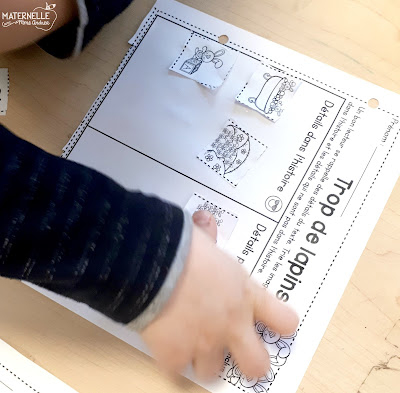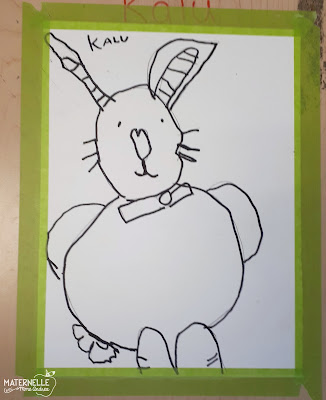Happy Easter Monday! I hope that you enjoyed/are enjoying a fantastic holiday weekend with your family.
I am just popping in today to talk some more about Close Reading in French. You may remember that I posted about it a few years ago – HERE and HERE.
I have had soo many requests over the past year or two to create more resources for French Close Reading, but I’ve had such a hard time finding both enough time and the perfect books!
But, I am really excited to be here today to talk about some close reading activities that we did with one of my new favourite books – Trop de lapins (affiliate link) by Trace Moroney.
(PS – I got my copy of the book from Scholastic. It was the Offre spécial in the March 2018 catalogue)
First of all, in case you missed it before, what is close reading?
Close reading is what you are doing when you read a text or a book thoughtfully and critically. You focus on important details and patterns within the book, and develop a deep understanding of the book (what happened, how/why the book was crafted, the meaning of the book or certain passages, etc.).
It is reading to analyze and reading to understand!
This can be tough in a second language. But, it is possible!
In maternelle with my school board, we are expected to teach and work on the following reading comprehension strategies:
– Faire des prédictions
– Activer ses connaissances antérieures
– Relever les points importants
– Créer des liens
– Se poser des questions
– Visualiser
– Inférer
– Analyser
– Faire la synthèse
It’s a lot! Especially for my students who speak English at home. We tackle these strategies using close reading. When we close read, we study the same book for about a week.
Teaching these strategies is so important. Reading is about so much more than just decoding, and sometimes we forget that. I have definitely caught myself patting myself on the back and congratulating myself for teaching students to successfully decode… all while forgetting that reading is so. much. more!
Reading is about understanding!
Without understanding and being able to make deeper connections with what you are reading, there isn’t any joy in reading. I don’t know about you, but I don’t want to teach my students to read just so they can “level up.”
We all know that life and academics are much, much easier if you are a proficient reader. I want my students to love reading! I want them to read all the time, and find joy, adventure, knowledge, and so much more from books.
This can only happen if they understand and connect with what they are reading!
Close reading is a great way to dive deep into some great stories and books during whole group time. I get to do the tricky decoding work, so that their brains are free to do the deep thinking work. And we all know that practice makes perfect – our students won’t learn to do this efficiently on their own if we don’t practice with them!
(Close reading is also a great way to sneak in some writing practice – both shared and independent!)
Trop de lapins by Trace Moroney is my latest favourite close reading book! Because of the bunnies, it was perfect last week, right before Easter, but it is also great any time of year. The actual theme of the book is about becoming a big brother or sister and all of the frustrations and joys that come along with it. It is a great fit for when you are teaching about families or changes within families!
We started off our study of the book by doing some predictions. I usually will do either predictions or visualizing on our first day of close reading. In the story, the big brother ends up having a little temper tantrum and yelling at his mom in front of his new baby siblings. We read the story up until that point and then predicted what might happen next.
We first shared our ideas out loud, and I picked one to draw on chart paper. We decided on a sentence to write, and we wrote it together (shared writing). My students came up and wrote the sight words they knew, and helped me decode new words.
Then, everyone recorded their own predictions independently. It’s okay if they use the same idea as me, or if they have another idea (I did get “my” idea from another student, after all!).
This student thought that the big brother would be sent to his room!
On Day 2, I always like to check for understanding. Sometimes, we will put the story in order, but if there are a lot of events that aren’t super sequential, we will complete a T-table of things that did/did not happen in the story. They did a great job at this!
After completing it together, they went to work and completed an independent sort.
We also used this story to make connections (we shared a time when we felt frustrated and/or threw our own little tantrums), explore new vocabulary, and look for the problem and the solution in the story.
We finished off our week by doing one of my favourite directed drawing activities from Proud to be Primary. I always like to try and incorporate a little craft or art activity at the end of a week of hard work.
Check out our cute bunny drawings!
If you are interested in trying close reading en français in your classroom, I currently have resources for three books in my TPT store:
– Trop de lapins
– La vie secrète des bonhommes de neige
– Gédéon va à l’école
I do have some more in the pipeline, and I am hoping it won’t take me as long this time to get them out!
I really appreciate all of your requests, and am so happy that more and more French teachers are giving close reading a try!! :)
PS – Are you a member of my FREE Resource Library for French primary teachers? If not, what are you waiting for?? Sign up below for access to every freebie I’ve ever made… and will ever make!









